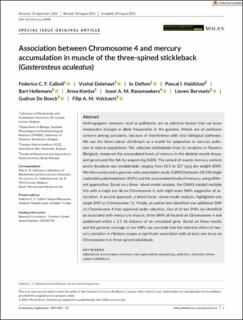| dc.contributor.author | Calboli, Federico C.F. | |
| dc.contributor.author | Delahaut, Vyshal | |
| dc.contributor.author | Deflem, Io S. | |
| dc.contributor.author | Hablützel, Pascal I. | |
| dc.contributor.author | Hellemans, Bart | |
| dc.contributor.author | Kordas, Anna | |
| dc.contributor.author | Raeymaekers, Joost A.M. | |
| dc.contributor.author | Bervoets, Lieven | |
| dc.contributor.author | De Boeck, Gudrun | |
| dc.contributor.author | Volckaert, Filip A.M. | |
| dc.date.accessioned | 2022-02-11T15:12:39Z | |
| dc.date.available | 2022-02-11T15:12:39Z | |
| dc.date.created | 2022-01-07T10:25:36Z | |
| dc.date.issued | 2021 | |
| dc.identifier.citation | Calboli, F. C. F., Delahaut, V., Deflem, I., Hablützel, P. I., Hellemans, B., Kordas, A., Raeymaekers, J. A. M., Bervoets, L., De Boeck, G. & Volckaert, F. A. M. (2021). Association between Chromosome 4 and mercury accumulation in muscle of the three-spined stickleback (Gasterosteus aculeatus). Evolutionary Applications, 14(10), 2553-2567. doi: | en_US |
| dc.identifier.issn | 1752-4571 | |
| dc.identifier.uri | https://hdl.handle.net/11250/2978546 | |
| dc.description.abstract | Anthropogenic stressors, such as pollutants, act as selective factors that can leave measurable changes in allele frequencies in the genome. Metals are of particular concern among pollutants, because of interference with vital biological pathways. We use the three-spined stickleback as a model for adaptation to mercury pollution in natural populations. We collected sticklebacks from 21 locations in Flanders (Belgium), measured the accumulated levels of mercury in the skeletal muscle tissue, and genotyped the fish by sequencing (GBS). The spread of muscle mercury content across locations was considerable, ranging from 21.5 to 327 ng/g dry weight (DW). We then conducted a genome-wide association study (GWAS) between 28,450 single nucleotide polymorphisms (SNPs) and the accumulated levels of mercury, using different approaches. Based on a linear mixed model analysis, the GWAS yielded multiple hits with a single top hit on Chromosome 4, with eight more SNPs suggestive of association. A second approach, a latent factor mixed model analysis, highlighted one single SNP on Chromosome 11. Finally, an outlier test identified one additional SNP on Chromosome 4 that appeared under selection. Out of all ten SNPs we identified as associated with mercury in muscle, three SNPs all located on Chromosome 4 and positioned within a 2.5 kb distance of an annotated gene. Based on these results and the genome coverage of our SNPs, we conclude that the selective effect of mercury pollution in Flanders causes a significant association with at least one locus on Chromosome 4 in three-spined stickleback. | en_US |
| dc.language.iso | eng | en_US |
| dc.publisher | Wiley | en_US |
| dc.rights | Navngivelse 4.0 Internasjonal | * |
| dc.rights.uri | http://creativecommons.org/licenses/by/4.0/deed.no | * |
| dc.title | Association between Chromosome 4 and mercury accumulation in muscle of the three-spined stickleback (Gasterosteus aculeatus) | en_US |
| dc.type | Peer reviewed | en_US |
| dc.type | Journal article | en_US |
| dc.description.version | publishedVersion | en_US |
| dc.rights.holder | © 2021 The Author(s) | en_US |
| dc.subject.nsi | VDP::Matematikk og Naturvitenskap: 400::Basale biofag: 470::Genetikk og genomikk: 474 | en_US |
| dc.subject.nsi | VDP::Matematikk og Naturvitenskap: 400::Zoologiske og botaniske fag: 480::Økotoksikologi: 489 | en_US |
| dc.subject.nsi | VDP::Matematikk og Naturvitenskap: 400::Kjemi: 440::Miljøkjemi, naturmiljøkjemi: 446 | en_US |
| dc.source.pagenumber | 2553-2567 | en_US |
| dc.source.volume | 14 | en_US |
| dc.source.journal | Evolutionary Applications | en_US |
| dc.source.issue | 10 | en_US |
| dc.identifier.doi | 10.1111/eva.13298 | |
| dc.identifier.cristin | 1976361 | |

